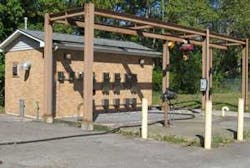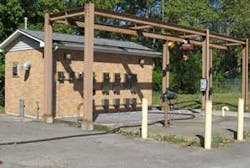Technology uses Collection System as an Active Part of Treatment
The collection system is often viewed simply as a means to transport wastewater to the treatment facility. The many hours that wastewater remains in the collection system helps promote the growth of “wild” bacteria including filamentous bacteria, Sulfate Reducing Bacteria (SRB), which lead to the production of hydrogen sulfide, and odor causing bacteria. As a matter of fact, the indigenous biological growth within the collection system can be harmful to infrastructure and is generally considered detrimental to objectives of wastewater treatment plants.
One company has developed a technology and service that use biological processes to turn the collection system into an active part of the treatment process. The system also can help reduce O&M costs for sewer maintenance and cleaning.
The system offered by In-Pipe Technology® Co. involves the introduction of high concentrations of select, facultative, symbiotic, spore-forming, naturally occurring, non-pathogenic bacteria at strategic locations in the outer reaches of a collection system.
In-Pipe’s microbiological treatment program is engineered for each specific sewer system, based on such factors as organic loads, distribution, collection system layout, and treatment objectives, among others. Battery-powered dosing units consist of a panel slightly larger than a shoe box containing a solenoid pulse pump operated by a small circuit board. The dosing panel holds a replaceable reservoir and can provide time controlled treatment for as long as 90 days.
Over time, the added bacteria convert the biofilm on the surface area of the infrastructure into a controlled, beneficial biological population. By out-competing the non-beneficial bacteria for nutrients, the microbes grow and populate the sewer pipes and lift station wet wells.
Using the collection system as a pre-treatment step improves WWTP efficiency in a number of ways. The bacteria work with or without oxygen inside the sewer system, converting organic materials and nutrients into carbon dioxide and nitrogen gas. Each pound of organic material and nitrogen removed in the sewer during transit, without energy input, is a pound that does not require treatment in the WWTP. This conversion involves two distinct operations, namely the conversion of TSS into a soluble format that bacteria can metabolize and the actual metabolism of the soluble material into carbon dioxide and nitrogen gas.
Case Study
The municipal wastewater treatment plant in Crown Point, IN, selected the In-Pipe system to reduce the amount of waste sludge for disposal, increase organic capacity and control odors at the plant.
Crown Point, in northwest Indiana approximately 45 miles from Chicago, spent nearly $200,000 on sludge-related expenses ranging from polymer costs to hauling and disposal fees. Population growth there also has increased sludge production and staff were faced with the prospect of expanding the existing sludge storage building. In addition, management hoped increasing the organic capacity of the facility would increase the MCRT (Mean Cell Residence Time) to push back the need for a new anaerobic digester expected to cost $1 million.
The collection system consists of 50% combined sewers and experiences significant infiltration and inflow (I/I). Several years ago, Crown Point built a 9 million gallon storage pond to help regulate the plant inflow during storm events. The conventional, activated sludge WWTP is designed for 5.2 mgd and can receive peak flows over 9 mgd, greater than twice the average annual flow of 4 mgd. Crown Point hoped the new program would help control odors associated with storing the raw wastewater at the plant, which was a concern of nearby residents.
Working under Ron Henley, WWTP Superintendent, WWTP foreman Chris Previs contacted In-Pipe to determine the effectiveness of treating the sewage before it gets to the plant. After careful review of the collection system, In-Pipe installed 20 injection points to dispense microorganisms into the sewer.
After five months of operation, Crown Point saw a decrease in its WAS (Waste Activated Sludge) production by 35%, improved the sludge volume index by greater than 35%, and increased volatile solids reductions. After nine months, the plant reported influent TSS load had decreased by 25% from 4,773 lbs/day to 3,565 lbs/day, and decreased ammonia load by 45% from 1,387 lbs/day to 755 lbs/day. One note worthy improvement was reduced filtrate ammonia concentration for stored sludge. This load ultimately increases the loading on the plant as the side-stream filtrate of ammonia is returned. Reducing this filtrate load was an unexpected benefit of the technology.
During the winter of 2008, the plant experienced the mechanical failure of two of three final clarifiers due to complications with the weather. As a result, nearly all of the biomass in the activated sludge system was eliminated through a washout of the remaining portion of MLSS. In-Pipe supplied additional microbes to select locations in the collection system and at the plant. Within two weeks, the grey, septic biomass was returned to a healthy brown color and the MLSS was rapidly rising.
In a letter thanking In-Pipe, Previs said “We feel we would have been in serious jeopardy of violating our permit if it was not for your quick response to our dilemma.”
Present Conditions
In-Pipe has serviced Crown Point for more than 16 months. In a recent report to the city council, Previs cited almost 85% of the In-Pipe expense was covered in savings from reductions in sludge and polymer usage, electrical consumption, and FOG control chemicals. In addition, staff reported reduced odors at the plant, an increased MCRT, and reduced O&M for sewer maintenance and cleaning. The new digester and expansion of the sludge storage building were postponed without schedule and Crown Point saved approximately $170,000 on sludge, electricity, and chemical expenses. WW

